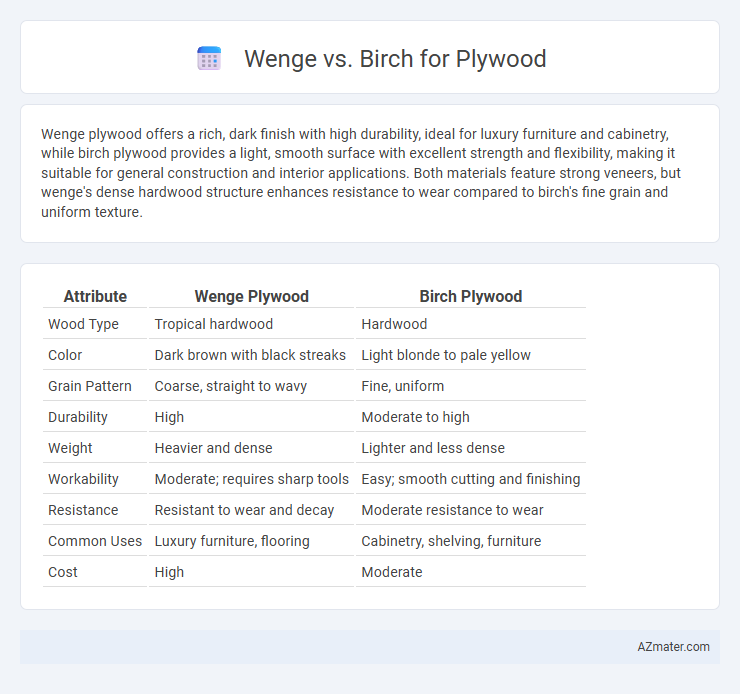Wenge plywood offers a rich, dark finish with high durability, ideal for luxury furniture and cabinetry, while birch plywood provides a light, smooth surface with excellent strength and flexibility, making it suitable for general construction and interior applications. Both materials feature strong veneers, but wenge's dense hardwood structure enhances resistance to wear compared to birch's fine grain and uniform texture.
Table of Comparison
| Attribute | Wenge Plywood | Birch Plywood |
|---|---|---|
| Wood Type | Tropical hardwood | Hardwood |
| Color | Dark brown with black streaks | Light blonde to pale yellow |
| Grain Pattern | Coarse, straight to wavy | Fine, uniform |
| Durability | High | Moderate to high |
| Weight | Heavier and dense | Lighter and less dense |
| Workability | Moderate; requires sharp tools | Easy; smooth cutting and finishing |
| Resistance | Resistant to wear and decay | Moderate resistance to wear |
| Common Uses | Luxury furniture, flooring | Cabinetry, shelving, furniture |
| Cost | High | Moderate |
Introduction to Wenge and Birch Plywood
Wenge plywood, sourced from the dark, dense African wenge hardwood, offers exceptional durability and a distinctive deep brown color with intricate grain patterns, making it ideal for high-end furniture and flooring. Birch plywood, derived from the light-toned birch tree native to Northern Europe and North America, is known for its smooth surface, excellent strength-to-weight ratio, and versatility in applications such as cabinetry, shelving, and decorative panels. Both types provide unique aesthetic and functional benefits, with wenge emphasizing rich visual texture and birch prioritizing structural stability and ease of finishing.
Appearance and Color Differences
Wenge plywood features a deep, rich chocolate-brown color with striking black veining, providing a bold and exotic look ideal for modern and luxurious designs. Birch plywood is characterized by its light, creamy-yellow tone with a fine, uniform grain pattern that offers a clean and natural appearance suitable for contemporary and Scandinavian-style interiors. The stark contrast between Wenge's dark, dramatic hues and Birch's soft, pale shades makes them distinct choices for different aesthetic preferences in woodworking and furniture projects.
Grain Patterns and Texture
Wenge plywood features a strikingly dark, coarse grain pattern with deep brown and black streaks, offering a bold and exotic aesthetic suited for luxury furniture and decorative applications. Birch plywood, in contrast, exhibits a fine, smooth grain with a light, creamy color, providing a consistent texture ideal for painting, staining, and cabinetry. The dense, closed-grain texture of birch ensures durability and a clean finish, while wenge's open, pronounced grain adds visual depth and a tactile surface.
Durability and Hardness Comparison
Wenge plywood offers exceptional durability and hardness due to its dense, tight grain structure, making it resistant to scratches and dents, ideal for heavy-use applications. Birch plywood, while also strong and durable, features a slightly softer surface compared to Wenge, providing better flexibility but lesser resistance to impact and wear over time. Wenge's superior Janka hardness rating of approximately 1630 contrasts with Birch's rating around 1260, highlighting Wenge as the harder and more durable choice for plywood projects requiring long-lasting performance.
Workability and Machining
Wenge plywood offers moderate workability with a dense and coarse grain that can cause wear on cutting tools, requiring sharp blades and slower feed rates for precise machining. Birch plywood is highly favored for its smooth texture and uniform grain, resulting in excellent workability and easy machining with minimal tool wear. Both materials respond well to sanding and finishing, but birch plywood is generally preferred for projects demanding intricate cuts and detailed craftsmanship.
Cost and Availability
Wenge plywood typically commands a higher price due to its exotic hardwood status and limited availability, making it less accessible for large projects. Birch plywood is widely available and more cost-effective, benefiting from abundant supply and consistent production in North America and Europe. Choosing birch plywood often results in significant cost savings without compromising on durability and strength.
Environmental Impact and Sustainability
Wenge plywood, sourced from the African Wenge tree, is less sustainable due to slow growth rates and habitat loss concerns, whereas birch plywood is more environmentally friendly, benefiting from faster growth and widespread plantation management. Birch plywood often comes from sustainably managed forests certified by organizations like FSC, reducing deforestation and promoting responsible forestry. The carbon footprint of birch plywood is generally lower, making it a preferable choice for eco-conscious consumers seeking sustainable wood products.
Applications and Best Uses
Wenge plywood is favored in high-end furniture and decorative applications due to its deep, rich color and strong, dense texture providing durability and aesthetic appeal for cabinetry and flooring. Birch plywood offers a lighter, smooth surface ideal for cabinetry, shelving, and interior paneling, delivering a consistent grain and excellent paintability for customization. Both types excel in structural applications, but wenge is preferred for statement pieces requiring strength and elegance, while birch is best for versatile, everyday furniture and built-ins.
Maintenance and Longevity
Wenge plywood offers superior durability and requires minimal maintenance due to its dense grain structure and natural resistance to moisture and wear. Birch plywood, while slightly less dense, provides good longevity with proper sealing and regular care to prevent water damage and surface deterioration. Both species benefit from occasional cleaning and protective finishes, but Wenge typically outperforms Birch in maintenance ease and extended lifespan.
Choosing Between Wenge and Birch for Your Project
Choosing between Wenge and Birch plywood depends on your project's aesthetic and durability requirements. Wenge plywood offers a rich, dark brown color with a pronounced grain, ideal for high-end furniture and decorative surfaces, while Birch plywood provides a lighter, consistent grain and excellent strength that suits structural and cabinetry applications. Consider Birch for budget-friendly, versatile use, whereas Wenge enhances visual impact with its exotic appeal but often comes at a higher cost.

Infographic: Wenge vs Birch for Plywood
 azmater.com
azmater.com